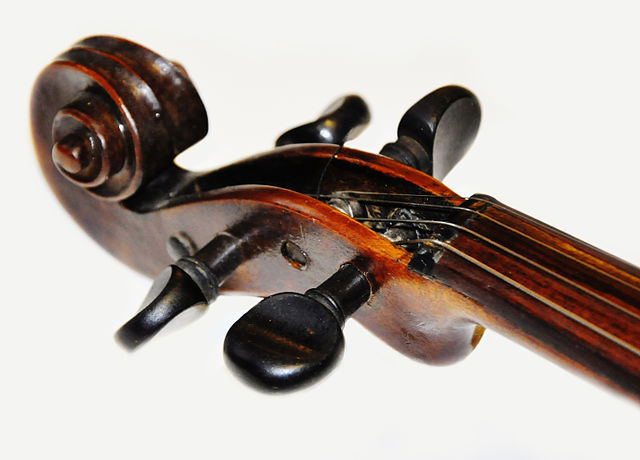Violins are delicate and lightweight, and yet their bodies support pounds and pounds of weight from the strings that stretch along the body of the instrument. Are violin strings really supposed to be so tight? While you don’t need to know all the science in order to play the instrument, here’s what we can teach you about violin string tension.
Summary
Violin strings are supposed to be quite tight, but it’s important not to over-tighten them. Keeping your strings at just the right amount of tension is the best way to ensure your violin plays in tune and sounds its best.
Table of Contents
How tight should violin strings be?
The tension of your violin strings is directly related to the tuning of each note. In short, if your G, D, A, and E are in tune, then your strings should be at the correct tightness! But of course, the details of the matter are not quite so simple.
The exact tension of each string varies not only by note, but by manufacturer as well. Some string manufacturers, like D’Addario and Thomastik, publish this information. There are also other resources, such as this website, offering a more detailed look on string tension. At the end of the day, however, knowing the tension measurement of your violin strings is not as important as simply making sure they are properly tuned.

Why should violin strings be tight?
Violin strings need to be tight to maintain proper tuning and resonance. Picture a completely slack string lying lazily on your fingerboard. Do you think dragging your bow across that string is going to make a good sound – or any sound at all? Of course not.
That’s obviously an extreme example, but you have to have a decent amount of tension in order to get a sound out of your strings. But it’s not as simple as pulling your strings as tightly as possible! Over-tightening can lead to shrill sounds or even broken strings. On the other end of the spectrum, overly-loose strings lack resonance. And if your strings are even a little off in either direction, your violin won’t be perfectly in tune.
How do you tighten violin strings (without breaking them)?
If you’re new to the instrument, it’s important to be gentle with your violin and to seek guidance from your teacher before you fiddle around too much with your strings. That being said, there are few simple techniques you can try to fix loose violin strings.
If the issue is minor, simply tuning up the violin may solve it. You can accomplish this with a piano or a tuning fork, but using a digital tuner is the easiest option for less-experienced musicians. In fact, you should make a habit of tuning up your instrument regularly, regardless of whether you’re having issues.
One important tip to remember is to loosen a string before you tighten it. You risk damaging the instrument if you forget this step! Any and every time you want to tighten a string on your violin, you must slacken it at least a little bit first.

What should you do if your violin strings keep becoming loose?
If your strings are acting up, you need to figure out the source of the problem before you can solve it. There are a number of issues that can cause your violin strings to keep coming loose, including:
- Improper winding: the string should be evenly coiled around the peg. If it isn’t, you’ll have to restring it (or have it restrung by a professional).
- Old, worn-out pegs: over time, pegs can become warped or simply succumb to wear and tear. A repair shop can replace or refit the pegs for you.
- Broken peg holes: even if the pegs themselves are fine, a damaged peg hole can result in the same issue. Once again, a repair shop can help with this.
Simple tasks like stringing your violin can be accomplished at just about any string repair shop. Better still, you can visit a luthier for this and pretty much any other issue you may have with your violin. Luthiers are craftsmen who make violins and other string instruments by hand, so you can bet they know how to deal with any issue you may have!
Will tight violin strings damage the violin?
Violin strings are supposed to be relatively tight. As such, violins are designed to withstand a fair amount of tension. If your strings are going to damage your instrument, the cause is far more likely to be because they were improperly strung rather than because they were overly tight.
Tight strings alone are unlikely to damage your violin, but it can be a warning sign if your strings constantly feel too tight. Poor-quality or worn-out strings may require excessive tightening in order to get them in tune. Besides the potential for breakage, overtightening can also lead to inconsistent tuning.
Will strings that are too tight damage the Violin?
Strings that are too tight are at risk of breaking, especially if they are well-worn or of poor quality. Buying quality violin strings and replacing them when needed will help ensure that they are less prone to breaking and easier to keep properly tightened.
One more word of caution, however: a broken string is unlikely to severely damage your instrument, but if the string breaks while you’re playing your violin, it may hit you. This doesn’t always happen – and when it happens, it doesn’t always hurt – but it’s far better to be safe than sorry.
Final Thoughts
While the science of acoustics is complicated, you don’t need to be a physics major to play the violin. If you pay attention to your instrument and trust your ears and fingers, you’ll soon learn how to tell when something is not right on your violin. Understanding how to tighten your violin strings is essential if you want to be able to care for your instrument and keep it properly tuned in the long run. And as we all know, a well-maintained instrument doesn’t just sound better: it’s a lot more fun to play!
